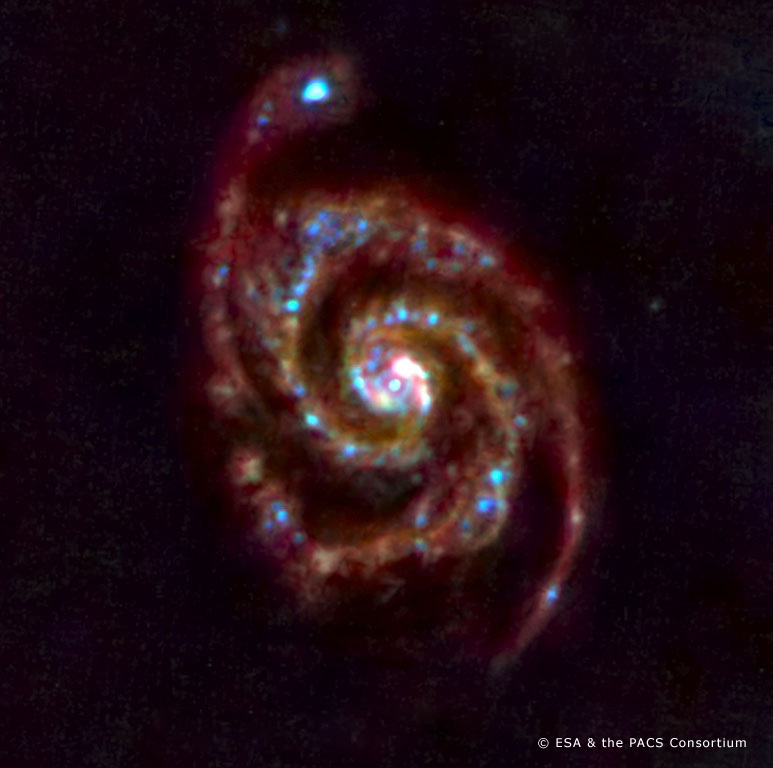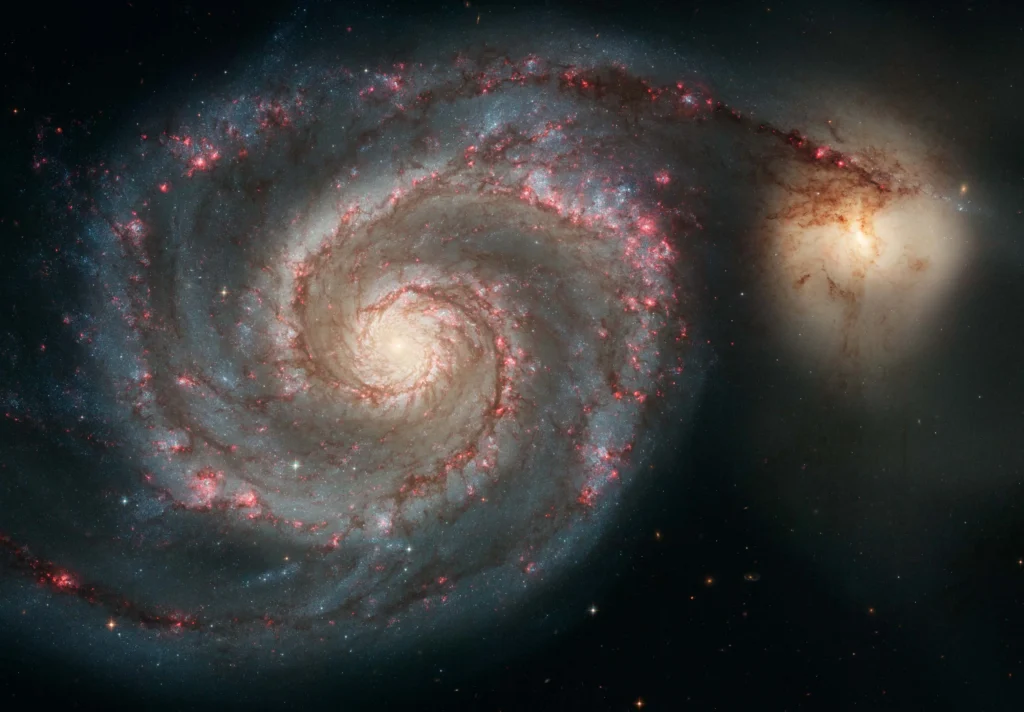Mysteries of Messier 51
© NASA Goddard
Table of Contents
On October 13, 1773, Charles Messier made a significant discovery while scouring the night sky for objects that could potentially be mistaken for comets. This celestial find, initially catalogued as M51 in Messier’s catalogue, later earned the moniker of the Whirlpool Galaxy.
The Whirlpool Galaxy, also known as Messier 51 or NGC 5194, is a striking spiral galaxy, spanning 76,900 light-years in diameter and located approximately 31 million light-years away from Earth in the constellation Canes Venatici. Its distinctive appearance, characterized by sweeping arms of stars and dust with a Seyfert 2 active galactic nucleus, has captivated astronomers and stargazers for centuries. At the heart of this cosmic masterpiece lies a bright central core, surrounded by intricately structured spiral arms that wind gracefully outward.
These enigmatic “spiral nebulae” remained a mystery until Edwin Hubble’s groundbreaking observations of Cepheid variables within some of these structures. This provided compelling evidence that they were not mere nebulae within our Milky Way but instead distant galaxies in their own right.
Some astronomers propose that the prominent appearance of the Whirlpool’s arms is influenced by its close encounter with NGC 5195, a small, yellowish galaxy located at the outer edge of one of the arms. Radio images unequivocally confirmed as the NGC 5195 passes behind M51, its gravitational tug triggers the formation of new stars through tidal forces, leaving behind a trail of luminous stellar nurseries. Professional astronomers have extensively studied this duo, aiming to unravel insights into galaxy structure, particularly associated with the spiral arms and the dynamics of galaxy interactions. With an apparent magnitude of 8.4, it is most easily observed with a small telescope, particularly during May.
The Whirlpool galaxy’s face-on orientation and proximity to Earth offer astronomers a unique opportunity to study the structure and star-forming processes of a classic spiral galaxy.
STRUCTURE OF WHIRLPOOL GALAXY

The structure of the Whirlpool Galaxy is characterized by its distinctive spiral morphology and interactions with its companion galaxy, NGC 5195. Here are the main structural components:
SPIRAL ARMS
The Whirlpool Galaxy features two striking spiral arms that wind in a clockwise direction. One of these arms notably deviates from a consistent angle. This pronounced spiral structure is thought to have been influenced by the close interaction between the Whirlpool Galaxy and its companion, NGC 5195. Approximately 500 to 600 million years ago, NGC 5195 likely traversed through the main disk of the Whirlpool Galaxy, contributing to the formation of its distinct spiral pattern. These arms are composed of stars, gas, and dust, arranged in a spiral pattern. The spiral arms are sites of active star formation, where dense clouds of gas and dust collapse to form new stars.
CENTRAL BULGE
The central bulge of the Whirlpool Galaxy is a dense, compact region at its core. It houses a concentration of stars tightly packed together, forming a luminous nucleus. Within this bulge, astronomers suspect the presence of a supermassive black hole, exerting gravitational influence over surrounding matter. The bulge serves as a focal point for the galaxy’s dynamics, contributing to its overall structure and evolution. Through observations of the central bulge, scientists gain insights into the formation and growth of galaxies, as well as the role of black holes in shaping their properties.
DISK
The disk spans a vast expanse surrounding the galaxy’s central bulge. Composed of stars, gas, and dust, this flattened region exhibits rotational motion, with stars orbiting the galactic center. Within the disk, dense molecular clouds serve as stellar nurseries, giving birth to new stars. Its spiral arms originate from the disk, showcasing ongoing star formation.
STELLAR POPULATIONS
The Whirlpool Galaxy hosts a diverse array of stellar populations, reflecting its complex evolutionary history. Within its spiral arms, young, hot stars illuminate the galactic disk, formed from dense clouds of gas and dust. These massive stars burn brightly, driving the vibrant colours seen in the galaxy’s spiral structure. In contrast, the central bulge contains older, cooler stars, tightly packed in a dense core.
PROPERTIES

The Whirlpool Galaxy, also known as Messier 51 or NGC 5194, possesses several notable properties that contribute to its significance in astronomy:
TIDAL FEATURES
The Whirlpool Galaxy, also known as Messier 51, exhibits striking tidal features resulting from its gravitational interaction with its companion galaxy, NGC 5195. These tidal features manifest as distortions and extensions in the outer regions of the Whirlpool’s spiral arms, caused by the gravitational tug-of-war between the two galaxies. The most prominent of these is the Northwest plume, extending up to 43 kiloparsecs (140,000 light-years) from the galaxy’s center. This plume, uniform in colour and likely originating from the Whirlpool Galaxy itself due to diffuse gas, is accompanied by two adjacent plumes with a slightly bluer hue, known as the Western plumes.
In 2015, a study identified two additional tidal features resulting from the interaction: the “Northeast plume” and the “South plume.” Remarkably, simulations suggest that a single passage of NGC 5195 into the Whirlpool Galaxy fails to replicate the Northeast tail, whereas multiple-passage simulations successfully reproduce this feature.
STAR FORMATION
Star formation in the Whirlpool Galaxy is a dynamic process that occurs primarily within its sweeping spiral arms. These arms are rich in dense clouds of gas and dust, providing the raw materials necessary for the birth of new stars. Within these molecular clouds, gravitational forces cause regions of higher density to collapse, forming protostars. As these protostars accrue mass and gravitational energy, they ignite nuclear fusion, becoming fully-fledged stars.
The Whirlpool Galaxy’s interaction with its companion, NGC 5195, plays a significant role in enhancing star formation. Gravitational forces generated during close encounters between the two galaxies compress gas clouds, triggering intense bursts of star formation. This interaction can also induce gravitational instabilities within the Whirlpool’s spiral arms, further promoting star formation activity.
Massive stars that emerge from these processes emit intense ultraviolet radiation, ionizing surrounding gas clouds. This radiation pressure can compress adjacent gas, leading to the formation of new stars in a feedback loop. Observations within the Whirlpool Galaxy reveal the presence of young stellar clusters within its spiral arms, indicative of ongoing star formation processes.
SUPERMASSIVE BLACK HOLE
At the heart of the Whirlpool Galaxy lies a supermassive black hole, an enigmatic cosmic entity with a mass millions to billions of times that of the Sun. This colossal gravitational behemoth exerts a profound influence on the surrounding galactic environment, shaping the dynamics and evolution of the Whirlpool Galaxy.
Supermassive black holes are thought to form through a process of accretion, where gas and dust accumulate in the central regions of a galaxy, eventually collapsing into a singularity. In the case of the Whirlpool Galaxy, the presence of a supermassive black hole is inferred from observations of the rapid motion of stars and gas near its center.
The gravitational pull of the supermassive black hole accelerates stars and gas to tremendous speeds, generating intense radiation and energy emissions. These phenomena can be detected across various wavelengths, from radio waves to X-rays, allowing astronomers to study the properties and behaviour of the black hole.
Despite their immense gravitational pull, supermassive black holes in most galaxies, including the one in the Whirlpool Galaxy, are currently in a quiescent state, with low levels of accretion activity. However, periodic fluctuations in accretion rates can lead to the emission of powerful jets of energetic particles and radiation, which can profoundly impact the surrounding interstellar medium and influence star formation processes within the galaxy.
TRANSIENT EVENTS
The Whirlpool Galaxy has witnessed the occurrence of three supernovae:
- In 1994, SN 1994I erupted in the Whirlpool Galaxy. It belonged to type Ic, indicating a massive progenitor star that had shed much of its mass. Peaking at an apparent magnitude of 12.91, it illuminated the galactic expanse.
- June 2005 brought the observation of type II supernova SN 2005cs in the Whirlpool Galaxy, reaching a peak apparent magnitude of 14, showcasing another stellar explosion event.
- May 31, 2011, marked the detection of a type II supernova in the Whirlpool Galaxy, designated SN 2011dh, reaching a magnitude peak of 12.1. Its spectrum exhibited unusually blue characteristics, hinting at a progenitor likely being a yellow supergiant rather than a red or blue supergiant.
A supernova impostor, later identified as a luminous red nova AT2019abn, was discovered on January 22, 2019, within Messier 51. The progenitor star was traced back through archival Spitzer Space Telescope infrared images, shedding light on its nature.
COMPANION GALAXY

The Whirlpool Galaxy is accompanied by a smaller companion galaxy known as NGC 5195. This interaction between the Whirlpool Galaxy and NGC 5195 is a fascinating phenomenon that shapes the morphology and dynamics of both galaxies.
NGC 5195, situated near one of the spiral arms of the Whirlpool Galaxy, is significantly smaller and less massive than its companion. Despite its size, NGC 5195 has a profound impact on the Whirlpool Galaxy through gravitational interactions. These interactions lead to tidal distortions, triggering bursts of star formation and shaping the overall morphology of the Whirlpool Galaxy.
The gravitational pull of NGC 5195 induces elongations and distortions in the outer regions of the Whirlpool Galaxy’s spiral arms. These tidal effects are visible as plumes and tails extending from the galactic disk. The most prominent of these features is the Northwest plume, which extends up to 43 kiloparsecs (140,000 light-years) from the galaxy’s center. Adjacent to it are two bluer plumes known as the Western plumes.
One of the significant consequences of the interaction between the Whirlpool Galaxy and NGC 5195 is the triggering of star formation. The gravitational forces exerted during close passages compress gas and dust clouds within both galaxies, leading to the formation of new stars. The regions where these tidal effects are most pronounced often coincide with areas of enhanced star formation activity. Young stellar clusters are observed within the spiral arms of the Whirlpool Galaxy, indicative of ongoing star formation processes triggered by the interaction with NGC 5195.
Observations reveal that the tidal features and star formation activity are intricately linked. The plumes and tails seen in the Whirlpool Galaxy are often associated with regions of intense star formation. The gas and dust compressed by the gravitational interactions provide the necessary material for the birth of new stars. Thus, the interaction between the Whirlpool Galaxy and NGC 5195 serves as a catalyst for stellar birth within the galactic system.
The ongoing gravitational interaction between the Whirlpool Galaxy and NGC 5195 has significant implications for their long-term evolution. It can affect their gas reservoirs, star formation histories, and overall morphologies. Understanding the nature of this interaction provides insights into the evolutionary processes shaping galaxies within the universe.
Lastly, the Whirlpool Galaxy belongs to a galaxy group known as the M51 Group or the Canes Venatici I Group. This galaxy group consists of several galaxies gravitationally bound together, with the Whirlpool Galaxy and its companion, NGC 5195, being the most prominent members. Other members of the group include smaller galaxies such as NGC 5194B, UGC 8493, UGC 8638, and a few others. The M51 Group is located in the constellation Canes Venatici, approximately 31 million light-years away from Earth.
